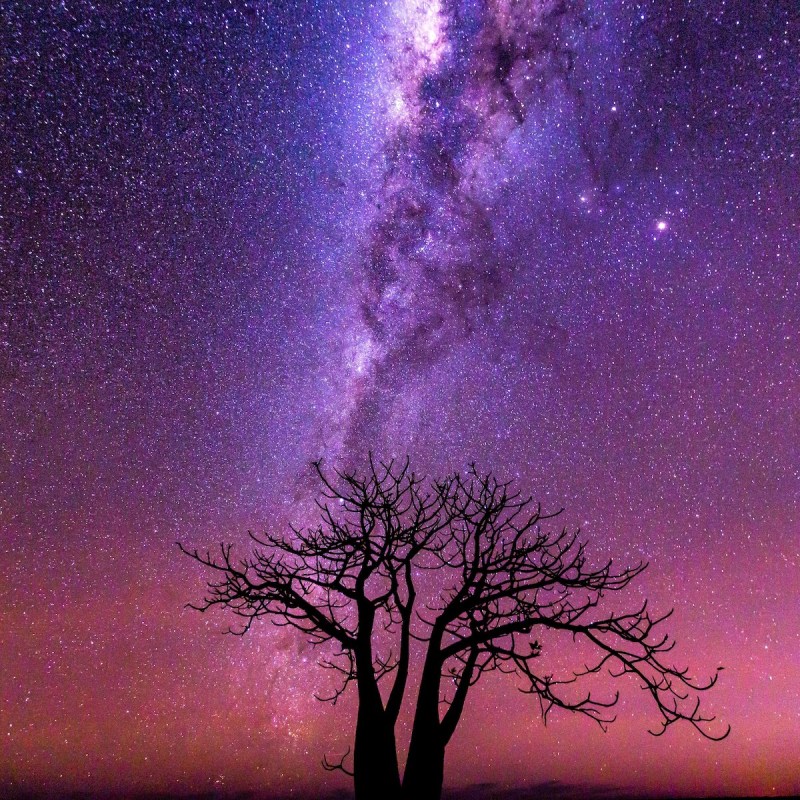
Look up when Down Under as Australia offers inspiring sky phenomena rarely seen elsewhere. Surf Morning Glory Clouds. Meet the Man in the Moon when he unfurls his rope ladder. And if you see hovering lights in your rearview mirror in the Outback, hit the gas and don’t look back. Here are a few Australian sky experiences on your horizon.
Videos by TravelAwaits

1. Riders On The Cloud
The Lonely Planet describes Morning Glory Clouds as “the next most spectacular thing to see in the sky after a full solar eclipse.” Tubular clouds roll in across the Gulf of Carpentaria like twisting serpents. The clouds are up to 3,000 feet high and 620 miles long — that’s the length of Britain — and travel at 40 miles per hour. A rarity in other parts of the world, Morning Glory Clouds are predictable in Burketown in Queensland from early September to early November when a band of as many as 10 somersaults into town.
The clouds aren’t a daily occurrence, but locals look to their beer for guidance. If the fridges of Burketown Pub have frosted over, there’s a good chance a Morning Glory Cloud will roll in. More people have climbed Mt. Everest than witnessed this natural wonder. Extreme hang gliders ride the Morning Glory like surfers riding waves. Tourists stand on terra firma to watch the spectacle or take scenic flights with companies such as Savannah Aviation. Watch the Morning Glory phenomenon here.

2. Beware The Min Min
Min Min are mysterious Outback lights that follow travelers. The orbs have fuzzy edges, like a swarm of bees, and hover above the ground. Normally white, but occasionally colored, the lights can split in two and go in different directions. Some Aboriginal people believe the lights are the spirits of elders. In folklore, anyone who follows the lights does not return.
The lights were named Min Min after the first recorded European sighting in 1918 when lights followed a stockman in the shanty settlement of Min Min — a Cobb and Co. changing station. His story involved liquor and seeing lights over the graveyard. There have been too many other sightings to reject his claim as mere drunkenness. Today, Min Min is a ghost town. All that remains is shattered glass and broken dreams evidenced by the eerie graves of lives cut short.
Boulia, the closest town, has a population of 312. Residents may not have a shopping mall, but they attract tourists like flies to a flytrap with their Min Min Encounter. The 45-minute show introduces travelers to the local legends about the Min Min lights. Move through settings of a pub, a homestead, a bush camp, a cemetery, and end up sitting on a simulated night bus ride through the moonlit outback terrain. Along the way, meet characters who claim to have seen the light! The show incorporates animatronic fiber optics and a taste of bush yarning.
Rational reasons for the Min-Min include mirages, bioluminescent insects, owls or birds, or a distant car light trapped in cold air. But if you see a strange light following you, I wouldn’t wait for it to catch you.

3. Mirages On The Nullarbor Plain
Drivers crossing the Nullarbor Plain see mirages. The desert sun heats the sand, which heats the air just above it. The hot air bends light rays and reflects the sky. Nullarbor is Latin for “no trees.” Edward John Eyre, the first European to cross the Nullarbor, described a “hideous anomaly, a blot on the face of nature, the sort of place one gets into bad dreams.” The Eyre Highway is named after him, and I wonder if he shifts uneasily in his grave every time a car passes over his namesake.
The highway takes travelers from Adelaide to Perth in a journey of about six days with tourist stops. Sights include wild camels and detours to towering cliffs with ocean views. The 1,000- mile journey includes one of the longest sections (91 miles) of straight road in the world. My mother drove this eternity in 1957 before the road had bitumen. I still gasp at her bravery. Today, with a sealed road, crossing the Nullabor is an adventure. But in the heat can come the mirage, a shimmering and enticing body of water in the distance. A cruel trick indeed to hot, thirsty travelers.
Pro Tip: Ensure your vehicle is in excellent condition and you carry plenty of water. The luxury train, the Indian Pacific, also crosses the Nullarbor.

4. A Staircase To The Moon
Broome in Western Australia is home to the Staircase to the Moon, an optical illusion occurring on nights when the full moon rises over the exposed tidal flats of Roebuck Bay. Moonlight bathes the mudflats so they appear like glowing bars. My son described it as “the Man in the Moon letting down a rope ladder so we can climb up the rungs to meet him.” Crowds watch from the Mangrove Hotel’s terrace but soon hush, leaving only the sound of the didgeridoo player registering each new rung.
Pro Tip: I prefer viewing the illusion from the terraced lawns where a local market coincides with the astronomical event. Grab a bowl of laksa and settle in for a private audience with the Man in the Moon.

5. A New Sky To Explore
If you have only stargazed in the Northern Hemisphere, then you know only half the sky. Gaze at a new map of the heavens above Australia.
Notable formations are visible, such as Alpha Centauri and Proxima Centauri, Omega Centauri (the biggest star cluster visible in the sky), the Coalsack Nebula, and two galaxies, the large and small Magellanic Clouds. Australia faces the Milky Way, so stargazers can see 100 times more stars than in the Northern Hemisphere.
The clearest constellation is the Southern Cross — or Crux to astronomers — whose stars are on our national flag. The Southern Cross has a strong cultural significance to Australians. On November 29th, 1854, miners battled against English soldiers at the Eureka Stockade. Australia’s flag was then the Union Jack, but the men hoisted a homemade flag and swore: “by the Southern Cross to stand truly by each other, and fight to defend our rights and liberties.” Like America’s Boston Tea Party, this battle represented a step toward liberty and democratic government.
Pro Tip: The battle was over in 30 minutes and claimed 38 lives. The flag, which the English shot to tatters, is on display at the Eureka Centre in Ballarat.

6. Is It A Bird? Is It A Plane? No, It’s An Emu.
Aboriginal people were the world’s first astronomers — using the stars as navigational tools and guides to the seasons. Astronomy tours in Australia point out the Southern Cross, but Aboriginal astronomy tours offer a fascinating perspective that defies traditional conventions of stargazing. Something indigenous guides show is the emu in the sky, a constellation composed not of stars but the dark patches between them.
The emu’s head is the dark between the stars in the Southern Cross. Follow your eyes down to make out the emu’s neck, body, and legs forming between the Milky Way’s iconic dust lanes. With our western concept of searching hard for stars, the emu is at first hard to make out, but the sky takes on a new vision and purpose once you do. Here’s an illustration.
Indigenous stargazing tours include Night Sky Astronomy in Alice Springs, the Cosmos Centre in Charleville, Night Sky Secrets in Cairns, Ayers Rock Resort, and Wula Gura Nyinda Eco Cultural Adventures in beautiful Shark Bay.

7. Southern Hemisphere’s First Dark Sky Park
Like Joshua Tree and Jasper (Canada) national parks, Warrumbungle National Park is a designated dark sky park by the International Dark-Sky Association. Warrumbungle was the first dark sky preserve in the Southern Hemisphere and is a 6-hour drive northeast of Sydney.
The high altitude and low humidity, and darkness make for phenomenal stargazing. Visit Siding Spring Observatory, Australia’s largest optical astronomy research facility and home to the Anglo-Australian Telescope, the largest optical telescope in Australia. The four-story-high telescope can even show quasars (gas revolving around a supermassive black hole) up to 12 billion light years away.
By day, the Siding Spring Exploratory hosts a free astronomy exhibition. See the telescope, read about its history, and learn of its many discoveries. There’s a gift shop, cafe, and a lookout over the iconic Warrumbungle National Park. As a working research facility, the observatory isn’t open to the public at night but offers fascinating tours and activities. On the World’s Largest Virtual Solar System Drive hurtle your car toward three-dimensional planets on billboards scaled in size and distance just as in outer space — only 38 million times smaller!
Pro Tip: Warrumbungle National Park offers campsites under the starriest of skies.
Or stay at Skywatch Observatory, where you can also use a Newtonian telescope.

8. NASA Steps Out Down Under
Three stations received the signals for the 1969 moon landing: Goldstone in California, Honeysuckle Creek (Canberra), and Parkes radio telescope (NSW.) Australian telescopes were the first to receive clear images, including Neil Armstrong’s epic one “small step for man, one giant leap for mankind.”
Find out more about Australia’s role in NASA’s Deep Space Network at Canberra Space Centre, one of three in the world that communicates with current space missions via one of the largest communications dishes in the Southern Hemisphere.
Check out the latest images from the solar system, see spacecraft models, learn what astronauts eat at the International Space Station, and see a piece of moon rock 3.8 billion years old. Free entry and there is a cafe and picnic grounds.
In central New South Wales, visit the Parkes Radio Telescope fondly known as “The Dish.” Its large surface makes the telescope highly sensitive in finding pulsars and rapidly spinning neutron stars. The Parkes telescope has found half of more than the 2,000 known pulsars.
The Dish is best known for relaying live TV pictures of Neil Armstrong and Buzz Aldrin’s first footsteps on the Moon. The sensitive equipment also picked up the astronaut’s heart rates through their spacesuits. Aldrin’s heart was pounding at 81 beats per minute, but Armstrong’s heart was racing at 112 beats per minute as he took that first big step.
Fans of the movie The Dish also flock to Parkes. This Australian classic is a humorous, irrelevant, and mostly true story of Australia’s role in the Apollo 11 moon mission, while released in 2000, holds a 96 percent rating on Rotten Tomatoes. The movie shows how Aussies are happy to laugh at themselves. Min Min lights anyone?
Here are some more potential adventures in Australia:
